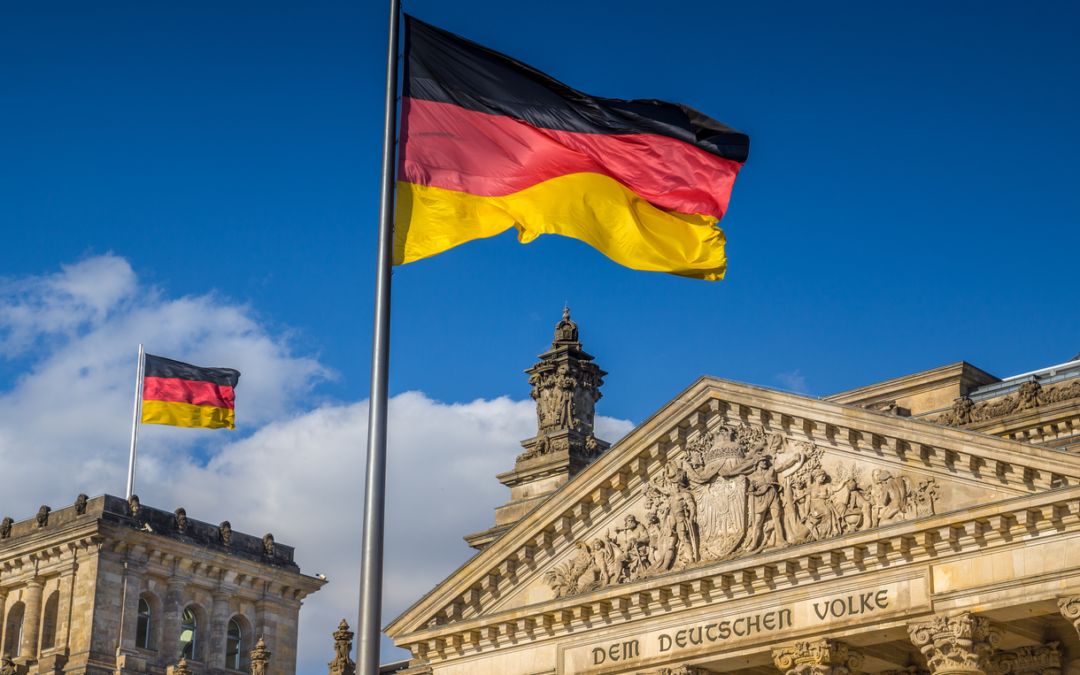Yesterday, elections for the Bundestag took place in Germany. The election results constitute a substantial defeat for the governing Conservatives (CDU/CSU). At the dawn of the 16 years long era of Chancellor Angela Merkel (CDU), Germany finds itself at a turning point. For the first time, it is very likely that the Federal Government will encompass up to three parties. The race remains too close to call who will lead the next government. It remains unclear whether Olaf Scholz (Social Democrats) or Armin Laschet (Conservatives) will be the next Federal Chancellor. The narrow results also open up the door to new possible coalitions. At the same time, the formation of the new government will be rather complex and take some time. According to German electoral law, the voters do not directly elect the Chancellor but determine the composition of the Bundestag by voting for candidates and party lists.
Monday morning’s preliminary official results did not indicate a clear winner as the two major parties appear to be nearly tied at around 24-26%.
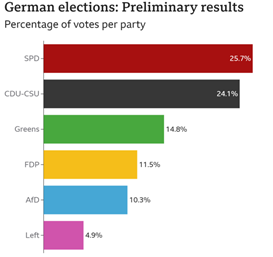
Preliminary official results including the difference (in percentage points) to the 2017 Federal Elections are: Conservatives (CDU/CSU) 24,1,% (-8,9%), Social Democrats (SPD) 25,7% (+5,2%), The Greens 14,8% (+5,9%), Liberals (FDP) 11,5,% (+0,8%), The Left (Die Linke) 4,9% (-4,3%), Alternative for Germany (AfD) 10,3% (-2,3%) and other parties 8,6% (+3,6%). The voter turnout remained similar to the previous elections at 76%.
The results display a substantial loss for the Conservatives, while the Social Democrats managed to improve their results, in comparison to the last Federal Elections. Commentators argue that SPD’s Chancellor candidate Olaf Scholz (SPD) managed to gain ground on the Conservatives by representing stability and continuity. He served as Vice-Chancellor and Federal Finance Minister of the current government. Furthermore, as opposed to the Conservatives, the Social Democrats stood firmly behind their candidate and demonstrated unity throughout the election campaign.
The results represent a substantial loss for the Conservatives, coming in with the worst result the party has seen at a Federal Election so far. Commentators argue that the Conservatives’ bad performance is due to disunity in the party, several scandals surrounding conservative policymakers and mistakes by Armin Laschet (CDU’s Chancellor candidate) throughout the election campaign.
The Greens achieved their best result in a Federal Election so far, almost doubling their results compared to the last elections in 2017. Albeit, the party still underperformed and came in third after ranking first in some polls in spring. The Liberals and the AfD retained almost the same position as in the last elections. However, the hard-left Linke party suffered losses and will just slightly enter the next German parliament.
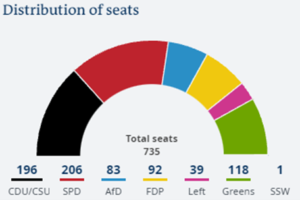
Likely coalitions:
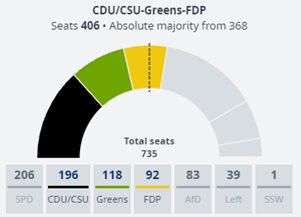
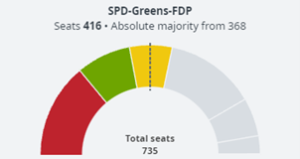
Due to the distribution of seats in the Bundestag, the following coalitions are possible and politically conceivable:
- Social Democrats (SPD) + Greens + Liberals (FDP) (‘Traffic Light Coalition’)
The ‘Traffic Light Coalition’ is the preferred option for the SPD to lead a government. However, such a constellation has few policy overlaps in fields such as taxation, with the FDP refusing any new taxes. Conversely both the SPD and the Greens want to introduce new taxes such as a ‘wealth tax’. Therefore, coalition negotiations would be rather difficult and bear an increased risk of failure. Albeit, as the Social Democrats came in first after the elections, the ‘Traffic Light Coalition’ becomes more probable. - Conservatives (CDU/CSU) + Greens + Liberals (FDP) (‘Jamaica Coalition’)
The ‘Jamaica Coalition’ would be the preferred path to the Federal Chancellery for the Conservatives. The FDP is more aligned with the Conservatives’ political agenda than The Greens. We can expect climate change to be one of the major crunch points throughout potential negotiations for a ‘Jamaica Coalition’. - Social Democrats (SPD) + Conservatives (CDU/CSU) or Conservatives (CDU/CSU) + Social Democrats (SPD) (‘Grand Coalition’)
While both the SPD and CDU/CSU oppose serving as a junior partner in another unpopular coalition with each other, the close results will raise some questions regarding a potential continuation of the current government. However, this scenario remains unlikely as a grand coalition remains the last resort for both parties. For the Social Democrats entering a coalition with the CDU/CSU would likely once again entail making concessions on many social policies which represent the core of the SPD’s current election campaign. For the Conservatives, on the other hand, it would represent the first time in history of entering a government as the junior partner.
A coalition between Social Democrats (SPD), Greens and Left (Die Linke) (‘Red-Red-Green Coalition’) will most likely not have a majority in the next Bundestag.
The narrow results make both the ‘Traffic Light Coalition’ with Olaf Scholz (SPD) as Chancellor as well as the ‘Jamaica Coalition’ with Armin Laschet (CDU) as Chancellor possible. The coming days and weeks will show which alternative turns out the most viable. The final composition of the Federal Government will depend on the Greens and the Liberals. Both parties will be the kingmakers of the next Chancellor. However, one of the parties will have to bite the bullet and join a government with a Chancellor they opposed throughout the election campaign. In the course of the negotiations both parties will have strong leverage against the Conservatives and the Social Democrats. In the end, it will come down to what party delivers the most compelling offer to both the Liberals and the Greens.
Key Statements by party leaders:
- Both Armin Laschet (CDU) and Olaf Scholz (SPD) interpreted the narrow results as a mandate to form the next German government.
- Despite the historically low results for the conservative CDU, Armin Laschet still interpreted the elections as a vote for a CDU-led government and promised to “do everything we can to form a government led by the CDU.”
- While the election remains too close to call, Olaf Scholz (SPD) was pleased with the results and is convinced to have received a clear mandate to become chancellor and lead a new government.
- Annalena Baerbock (Greens), whose party will play a decisive role in crowning the new government, stressed her desire for a “climate government” but refrained from making any clear statements concerning a preferred coalition.
- Christian Lindner (Liberals), who is – alongside Annalena Baerbock – perceived as a kingmaker in these elections, argued that Liberals and Greens should hash out their positions before including SPD or CDU in coalition negotiations. Given the German tradition of the election winner to initiate coalition talks, this advance is highly notable.
Traditionally the strongest party of the election is usually tasked with the formation of the next government. Upon its invitation, the parties will meet in the coming week for first exploratory talks to determine if there is enough common ground between them to form a government together. However, this time all eyes are on the Liberals and the Greens as they become the kingmakers for the next Chancellor. Due to the narrow results and the necessity to involve up to three parties in the coalition talks, we expect the negotiations to last at least until the end of 2021. Moreover, both the Greens and the SPD will most likely run a general vote among their members to greenlight the coalition agreement.
Furthermore, several crunch points must be resolved by the negotiators. Among them are measures to tackle climate change, taxation, and restarting the economy after the pandemic. For the time being, the current government under Angela Merkel will remain in office as a caretaker for official duties. However, it is a constitutional tradition that a caretake government refrains from initiating any far-reaching legislative projects.
Update State Elections in Berlin & Mecklenburg-Vorpommern
In addition to the federal election for the Bundestag, two state elections were held in the German states of Mecklenburg-Vorpommern and Berlin over the weekend. Overall, the Social Democrats´ success on the federal level was reflected in the results of the regional elections.
Berlin is not only Germany’s most populous city and capital but also constitutes one of the country’s 16 federal states. The city state’s mayoralty has consistently been held by the Social Democrats for two decades.
Despite a rocky start to the campaign and a plagiarism scandal involving the party’s candidate for “Governing Mayor” Franziska Giffey, the Social Democrats managed to retain their position as the strongest party in Berlin’s senate. Similar to Annalena Baerbock’s campaign for the Chancellery, The Green’s candidate Bettina Jarasch lost a significant lead in the months leading up to the elections. However, The Greens still attracted more voters than the Conservatives. Giffey now faces the choice between continuing the current “Red-Red-Green Coalition” with The Greens and hard-left Linke party or entering a “Germany Coalition” with the Conservatives and the Liberals, instead.
Berlin preliminary official results including the difference (in percentage points) to the 2016 State Elections are: Social Democrats (SPD) 21,4% (-0,2%), The Greens 18,9% (+3,7%), Conservatives (CDU) 18,1% (+0,5%), The Left 14,0% (-1,6%), Liberals (FDP) 7,2% (+0,5%), Alternative for Germany (AfD) 8,0% (-6,2%) and other parties 12,4% (+5,0%).
In Mecklenburg-Vorpommern, one of the least populous and rural German states, the incumbent minister-president Manuela Schwesig (Social Democrats) secured a resounding win ahead of the right-wing Alternative for Germany and the Conservatives. The Social Democrats has been the strongest party in the state’s capital of Schwerin since 1998 and is likely to continue the grand coalition with the Conservatives. Schwesig now faces the choice between continuing the current coalition with the Conservatives or entering a coalition with the Linke party instead.
Mecklenburg-Vorpommern preliminary official results including the difference (in percentage points) to the 2016 State Elections are: Social Democrats (SPD) 39,6% (+9,0%), Alternative for Germany (AfD) 16,7% (-4,1%), Conservatives (CDU) 13,3% (-5,7%), The Left 9,9% (-3,3%), The Greens 6,3% (+1,5%), Liberals (FDP) 5,8% (+2,8%) and other parties 8,4% (-0,2%).
This was first posted on Miller Meier’s website.
